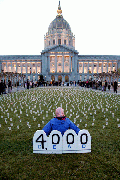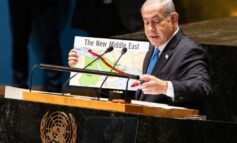
WASHINGTON — The escalation of fighting between Mahdi Army militiamen and their Shi’a rivals, which could mark the end of Moqtada al-Sadr’s self-imposed ceasefire, also exposes Gen. David Petraeus’s strategy for controlling Sadr’s forces as a failure.
Petraeus reacted immediately to Sunday’s rocket attacks on the Green Zone by blaming them on Iran. He told the BBC the rockets were “Iranian provided, Iranian-made rockets,” and that they were launched by groups that were funded and trained by the Quds Force of Iran’s Islamic Revolutionary Guard Corps (IRGC). Petraeus said this was “in complete violation of promises made by President [Mahmoud] Ahmadinejad and other most senior Iranian leaders to their Iraqi counterparts.”
Petraeus statement was clearly intended to divert attention from a development that threatens one of the two main pillars of the administration’s claim of progress in Iraq — the willingness of Sadr to restrain the Mahdi Army, even in the face of systematic raids on its leadership by the U.S. military and its Iraqi allies.
The rocket attacks appear to have been one of several actions by the Mahdi Army to warn the United States and the Iraqi government to halt their systematic raids aimed at driving the Sadrists out of key Shi’a centres in the south. They were followed almost immediately by Mahdi Army clashes with rival Shi’a militiamen in Basra, Sadr City and Kut and a call for a nationwide general strike to demand the release of Sadrist detainees.
Even more pointed was a strong warning from Sadr aide Abdul-Hadi al-Mohammedawi to the United States as well as to the Islamic Supreme Council of Iraq (ISCI), whose Badr Organization militiamen, in the uniforms of Iraqi security forces, have targeted the Madhi Army throughout the south. “They don’t seem to realize that the Sadrist trend is like a volcano,” he told worshippers Friday in Kufa. “If it explodes, it will crush their rotten heads.”
The signs that the Madhi Army will no longer remain passive mark a major defeat for the U.S. military command’s strategy aimed at weakening the Mahdi Army.
When he took command in Iraq in early 2007, Petraeus recognized that the U.S. occupation forces could not afford to wage a full-fledged campaign against the Mahdi Army as a whole. Instead it adopted a strategy of dividing the Sadrist movement.
Petraeus and the ground commander in Iraq, Lt. Gen. Ray Odierno, hoped that there were leaders in the Sadrist movement who would be willing to give up further military resistance and accept the U.S. occupation and the existing government.
For months, the command tried to generate a “dialogue” with “moderates” in the Sadrist camp. It issued a series of statements hailing Sadr’s willingness to change the purpose of his movement. Most recently, on Jan. 17, Odierno said, “I believe he is trying to move forward with more of a religious organization and get away from a militia type-supported organization.” But he admitted, “That could change.”
Meanwhile, Petraeus targeted selected elements of the Mahdi Army in raids in Sadr City and the Shi’a south, portraying its targets as “criminals” and “rogue elements” which had broken away from Sadr and were armed, trained and financed by Iran. Odierno suggested in his Jan. 17 press briefing that such renegade groups were causing “the majority of the violence.”
But the “moderate” Sadrists who would be willing to make a deal with the U.S. never materialized. Last July, a U.S. commander in Baghdad claimed that Sadrist representatives had initiated “indirect” talks with the U.S. military. But in January, Odierno would say only that they had been meeting with “local leaders” in Sadr City, not with representatives of the Sadrist movement.
The Mahdi Army’s blunt warnings of military countermeasures followed months of raids against Sadr’s political-military organization by both U.S. forces and the Badr Organization. According to a senior Sadrist parliamentarian, between 2,000 and 2,500 Mahdi Army militiamen had been detained since Sadr declared a ceasefire last August.
The raids have been aimed at weakening the Madhi Army’s political hold on Shi’a cities in anticipation of eventual provincial elections.
During 2007 there were signs of strong support for Sadr in Najaf, Basra and Karbala, as Sudarsan Raghavan reported in the Washington Post last December. In Najaf, portraits of Sadr and his father, Grand Ayatollah Mohammed Sadiq Sadr, who was assassinated by Saddam Hussein’s security forces in 1999, had “mushroomed defiantly in the streets.”
Sadr’s image had also been “pervasive” in Karbala, according to Raghavan, until security forces loyal to the ISCI arrested more than 400 of Sadr’s followers in an obvious effort to destroy its organization in the city.
For months Sadr had refrained from authorizing a full-fledged response to such attacks on his forces. But Tuesday an officer at Sadr’s headquarters in Najaf said the Mahdi Army should be prepared to “strike the occupiers” as well as the Badr Organization.
Revealing the contradictions built into the U.S. position in Iraq, even as it was blaming Iran for the alleged renegade units of the Mahdi Army, the U.S. was using the Badr Organization, the military arm of the ISCI, to carry out raids against the Mahdi Army. The Badr Organization and the ISCI had always been and remained the most pro-Iranian political-military forces in Iraq, having been established, trained and funded by the IRGC from Shi’a exiles in Iran during the Iran-Iraq war.
It was the ISCI leader Abdul-Aziz al-Hakim who had invited two IRGC officers to be his guests in December 2006, apparently to discuss military assistance to the Badr Organization. The Iranian officials were seized in the home of home of Hadi al-Ameri, the leader of the Badr Organization and detained by the U.S. military. The Bush administration continued throughout 2007 to cite those Iranian visitors as evidence of the IRGC’s illicit intervention in Iraq.
But the Badr Organization had become the indispensable element of the Iraqi government’s security forces, who could be counted on to oppose the Mahdi Army in the south. And in a further ironic twist, it was the leaders of the ISCI and of the Nouri al-Maliki government, which depended on Iranian support, who insisted last summer and fall that the United States should credit Iran with having prevailed on Sadr to agree to a ceasefire. The close collaboration of the U.S. command with these pro-Iranian groups against Sadr appears to be the main reason for the State Department’s endorsement of that argument last December.
The Petraeus assertion that the rocket attacks on the Green Zone were Iranian-inspired strongly implied that Iran is still providing arms to Shi’a militias. However, Odierno told a press briefing in mid-January, “We are not sure if they’re still importing [sic] weapons into Iraq.”
That admission came only after many months in which U.S. officers in the border provinces were unable to find any evidence of arms coming across the border from Iran.
Those officers also found no trace of the alleged presence of the IRGC personnel in Iraq. Last November, the French weekly news magazine Le Point quoted Maj. Scott A. Pettigrew, the military intelligence chief in Diyala province on the Iranian border, as saying, “I have never seen any activity or presence of the Quds Force. I see nothing here that resembles a proxy war with Iran.”
Gareth Porter is an historian and national security policy analyst. The paperback edition of his latest book, “Perils of Dominance: Imbalance of Power and the Road to War in Vietnam,” was published in 2006.






Leave a Reply